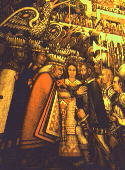More about Mexico:
| Mexico by Bus | |
| Mexico Profundo | |
| Mexico City, June 20, 1995 | |
| Todos Somos Marcos | |
| Women Filmmakers in Mexico | |
New! THE CONQUEST OF MEXICO Standards-based classroom ready resource for teachers. Easy to use in several formats, including teacher-directed slide shows with an LCD or large screen monitor, overheads, photocopied handouts, or in a computer lab setting. Available now from |
 |
Cortés and La Malinche "I would like to see a statue of Cortés in Mexico City," writer Carlos Fuentes said in an interview a couple of years ago. "I think that is more honest. We must accept the father as well as the mother." There is none. There is a monument to Columbus, who never set foot in Mexico, and one to Cuauhtémoc, the last Aztec leader, whose capture on August 13, 1521, marked the fall of one great empire and the rise of another. But Cortés, who more than any other individual shaped the future of the country and arguably the world, is almost uniformly vilified in Mexico today. When I confessed to one Mexican amiga that I had a certain admiration for the man, she turned to me with derision: "You admire a thief and a torturer?" La Malinche, his consort, translator and advisor, without whom the diplomatic maneuvering which was as much a part of the conquest as the fighting would have been impossible, is often regarded as a whore and traitor. Her name has come to be used to describe a person who turns his back on his own culture: malinchista. That Cortés was able to wheel and deal with the natives on a complex level was due to two great strokes of luck. The first, while he was still at Cozumel, was the addition to his band of Jerónimo de Aguilar, a priest who had been shipwrecked on the coast eight years before and kept as a slave by Yucatan Mayas. He spoke Spanish and Mayan. Then, after their first military victory in what is now the state of Tabasco, they received among other forms of tribute 20 Indian women; one of them was Malinche, christened Doña Marina. Malinche was the daughter of the lord of a Náhuatl-speaking town. After her father died and her mother remarried, she became an inconvenient stepchild and was secretly sold as a slave to a Mayan lord, while her mother and stepfather gave out that she had died. Now she had been given to these strangers. No one could have guessed how important that would be. Now Cortés could speak to the Aztecs, not with grunts and signs but with precise and often devious detail. Cortés would speak to Aguilar in Spanish, Aguilar would speak to Malinche in Mayan, and she would translate into Náhuatl, the lingua franca of the central Mexican highlands. We spent an afternoon at the ruins of Quiahuiztlán with a young musician from Jalapa. Sitting on the spot where I imagine Cortés sat, staring out at the sea and plotting the conquest of Mexico, I asked him what he thought of La Malinche. "Was she a traitor or a heroine? Didn't she have reason to oppose the tyranny and oppression gripping Mexico, and to hope for relief from the powerful strangers?" "It is a story of love," he told me. "Love is more important than politics."
NOTE:
Quotes from Díaz and Cortés are from the following sources: |


